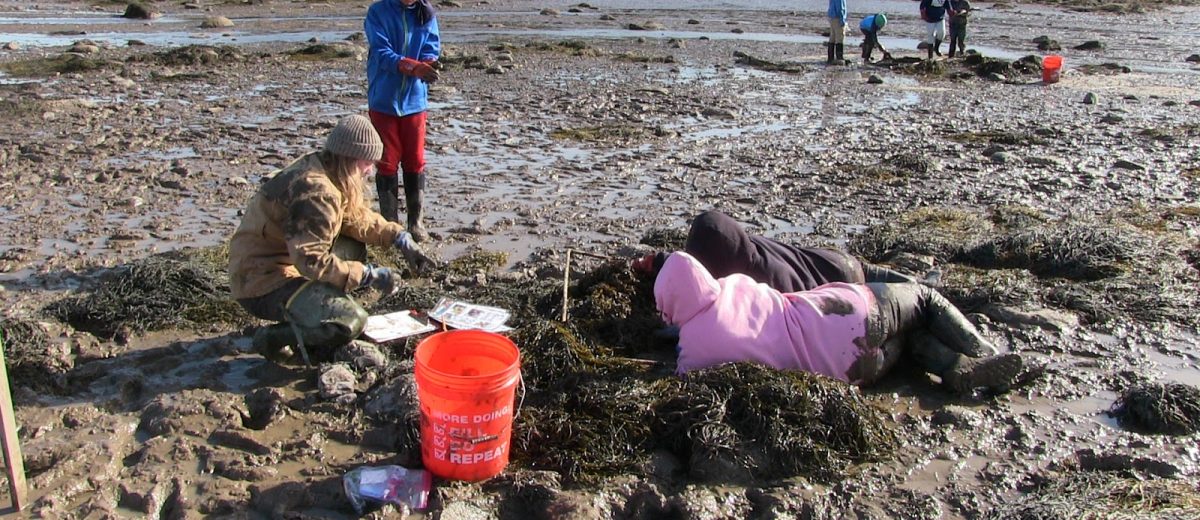by Bill Zoellick and Sarah Hooper
Now that the school year is underway, we’ve really jumped in (…to the mud?) with our education partnerships with RSU-24. We begin with this picture of how one middle school student totally got into her crab survey work this past week.
First, some background. This year RSU 24 asked us to help them greatly expand project-based learning (PBL) within the district. For the last two years, Bill worked with high school students in the Pathways program at Sumner Memorial High School to collect real data that supports shellfish management in Gouldsboro. Now the district wanted to expand these CSI-Maine (Maine Community Science Investigations) activities to middle school science students in all four district K-8 schools. They invited us to implement a path that would engage a group of 6-8th graders in a program that, again, collects real data to help their local community. Fortunately, we have funding from the Elmina B. Sewall Foundation intended for precisely this kind of work, so we were able to say YES!
Well, saying yes is easy; making it happen is something else. Putting together the protocols, equipment, and logistics to get students from four schools out in the field and collecting useful data before it got too cold was a challenge. Fortunately, a project like this happens because many people in the community stepped up to support this unique partnership that connects students with their local landscape and community. We were able to adapt an established green crab survey protocol developed by colleagues at the Gulf of Maine Research Institute to use in our project. We had amazing help from teachers and district administrators to envision and scope the project; from Pathways students at the high school to encourage and mentor the middle school students who were involved (our “crab ambassadors!”); and from Melinda Boumans at Anderson Maine and Hardware (Thanks, Melinda!) to outfit the students with boots and gloves. Heidi Leighton and Hannah Annis, the regional area biologists from the Maine Department of Marine Resources (DMR), and DMR intern Emily Miller were terrific career role models and middle school wranglers on the mud flats. And Gouldsboro Shellfish Warden Mike Pinkham was on hand to “rescue” those stuck in the mud and provide a direct connection with the shell fishery that will benefit from the work. Finally, we owe thanks to the Schoodic Community Fund. They provided financial support for the gear lending library — boots, gloves and more — that made it possible to take all the students into the field.
All the pieces came together early last Thursday. Twenty-nine middle school students — assisted by 7 students from the Sumner High School Pathways program, DMR staff, Clam Warden Mike, and teachers and other educators (including Bill and Sarah) — surveyed 20 seaweed plots for green crabs in “Deep Cove,” near Point Francis at the north end of the Paul Bunyan subdivision in Gouldsboro. They will use the data from the samples they collected to explore questions about the relationship between green crab density, tidal gradient, and seaweed patch size. These questions build on work that the DMR is doing in other coves.
So what’s the fuss? From an educational standpoint, we are working with RSU 24 to address a problem that is common in most districts: it is in middle school that many students decide that they are not good at science and don’t like it. We intend to turn that around.
The “Big Crab Hunt” was not the ONLY thing we did last week. We also retrieved clam experiments from Deep Cove and from a site at the upper end of West Bay that has been closed to clam harvesting for years. Sumner Pathways students sieved the clams, which are now sitting in a freezer awaiting measurement and counting. A quick look at the samples as we bagged them suggests that there is a big difference between the two sites in growth and survival. That will make for another year of interesting data analysis. Connecting students with real science that matters to them and their community opens doors not just to improved science skills and understanding, but to creative problem-solving in the world they’ll soon be leading.
And … now that we have collected all those field samples, we will begin working with teachers and students to plan out the rest of the year. Expanding our work to the entire grade 6-12 science program provides a huge opportunity to make a difference for students and for us to develop new ways to support programs at the district and community level. Woot woot!
